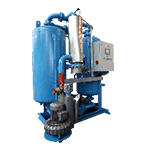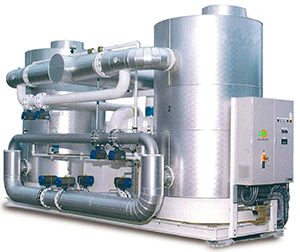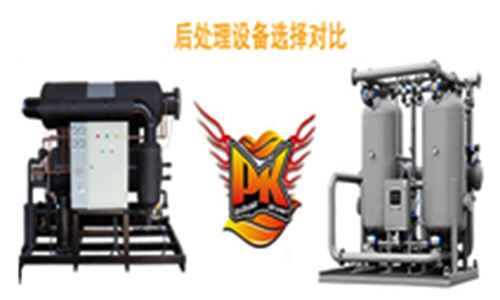Principle difference:
1.Differences in working principles:
A cryogenic dryer is based on the principle of variable temperature dehumidification, which exchanges heat between compressed gas and refrigerant in a shell and tube manner. The gas cools to a certain temperature, condenses a large amount of liquid water, and is separated by a gas-liquid separator before being discharged from the equipment, thus achieving the purpose of dehydration and drying.
Adsorption dryer is based on the principle of pressure swing adsorption, which fully contacts compressed air with desiccant under a certain pressure, adsorbs most of the moisture in the desiccant, and then fully regenerates the desiccant through pressure swing and temperature change, and repeats the cycle.
2.Differences in water removal efficiency:
Due to the constraint of the refrigeration compressor, the cryogenic dryer may experience ice blockage when the refrigerant temperature is too low, resulting in equipment shutdown. The dew point temperature of the compressed gas usually drifts between 2~10 ℃, and the dew point deviation is significant.
The adsorption dryer only utilizes the physical water absorption characteristics of the adsorbent. The equipment fully regenerates and restores the original characteristics of the desiccant through pressure and temperature changes, thereby ensuring the stability of the compressed gas dew point. The dew point can reach below -40 ℃, achieving deep water removal.
3.Differences in energy loss:
Freezing dryers mainly rely on refrigerant compressors for refrigeration, consuming a large amount of electricity, and some gases are discharged with water.
The control electrical energy consumption of the adsorption dryer is within 100W per hour, mainly for the energy consumption of adsorbent regeneration work. It can be energy-saving treated according to the customer’s on-site working conditions, such as electric auxiliary heating, steam heating, compressor waste heat, etc.
4.Differences in failure rates:
The cryogenic dryer mainly includes a refrigeration system, electrical control, and heat exchange system. However, the refrigeration system involves strict welding and cleaning processes for refrigerant pipelines, and the manufacturing process is complex and demanding, so the quality cannot be fully guaranteed. This is the main reason for the high failure rate and short service life of cryogenic dryers so far. At the same time, higher requirements are needed for later use conditions, such as ventilation, cleanliness, and stable power supply.
The adsorption dryer mainly includes an air system and an electronic control system. The equipment body is a mechanical structure, and only the pneumatic valve components have the possibility of failure due to frequent operation. Therefore, in general, the failure rate of the suction dryer is much lower than that of the subcooled dryer. At the same time, the requirements for later use conditions are relatively low.

(Non gas consuming blower heat adsorption drying)
Selection suggestions:
Adsorption dryers are superior to freeze dryers in terms of stability and effectiveness. It is recommended that customers choose micro heat dryers with an energy consumption of 7%, waste heat dryers with an energy consumption of 3%, and dryers with an energy consumption of 0% according to their actual working conditions and requirements.
The comprehensive performance advantages of adsorption drying with mature technology have been increasingly recognized by more and more users. Mature users consider energy consumption, failure rate, and post maintenance comprehensively, and adsorption drying will be the best choice.

(Non gas consuming compression adsorption drying)

